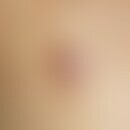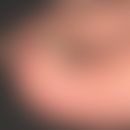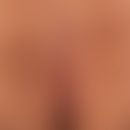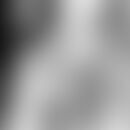Synonym(s)
DefinitionThis section has been translated automatically.
Icterus (from Greek ícterus = jaundice), generally refers to the discoloration(dyschromia) of visible tissues due to the accumulation of bilirubin in the skin, sclerae and internal organs (perceptible discoloration of the skin in the case of bilirubin > 3 mg/dl, perceptible discoloration of the sclerae in the case of bilirubin > 2 mg/dl). The sclerae are affected at an early stage, as bilirubin preferentially stains the elastic fibres. The scleral icterus is therefore an early and important diagnostic leading symptom for clarification of the symptom.
Pseudo-octerus is a deposit of dye on the skin and/or sclerae, e.g. through repeated, excessive carotene consumption(carotene jaundice, e.g. in infants through fed carrot pulp) at normal bilirubin levels.
Xanthoderma is a yellowing of the skin caused by medication (e.g. Qinacrin).
ClassificationThis section has been translated automatically.
According to the site of the causative disorder:
- Prehepatic
- Intrahepatic
- Posthepatic.
In prehepatic icterus, there is an increase in bilirubin, the cause of which lies "before the liver" (e.g., due to hemolysis).
In intra- and posthepatic icterus, there is a bilirubin increase in the liver or behind the liver, respectively. This is always obstructive or non-obstructive cholestasis.
According to the cause of jaundice:
- Hemolytic icterus (prehepatic icterus).
- Hemolytic anemia
- Hepatocellular icterus (hepatic or parenchymal icterus)
- Familial hyperbilirubinemia syndromes (e.g.: Icterus intermittens juvenilis; Crigler-Najjar syndrome, Dubin-Johnson syndrome, Rotor syndrome, Idiopathic recurrent cholestasis).
- Infectious hepatitis (viruses, bacteria, malaria)
- Chronic hepatitis and liver cirrhosis
- Drug- or toxin-induced hepatitis (phenprocoumon, paracetamol, ajmaline, amiodarone; phenothiazines, sex hormones, alcohol, carbon tetrachloride, poisoning by tuberous leaf fungi)
- Congestive liver in right heart failure
- Cholestatic (occlusive) icterus: Impaired bile flow; caused by congestion extending from liver parenchyma (intrahepatic cholestasis) to papilla Vateri.
- Intrahepatic cholestasis (disturbance of bile secretion in the liver)
- Hepatitis, liver cirrhosis
- Viral hepatitis (A-E), hepatotropic viruses (CMV, EBV)
- Autoimmune hepatitis
- Storage diseases(hemochromatosis, Wilson's disease)
- "Fat overloading syndrome with parenteral nutrition
- Progressive destruction or hypoplasia of the bile ducts
- Primary biliary cirrhosis
- Primary sclerosing cholangitis
- "Vanishing bile duct syndrome after liver transplantation
- Idiopathic adult ductopenia
- Congenital disorders of liver function with cholestasis
- Vascular liver disease (rare)
- Ischemic cholangitis after infusion of FU or after liver transplantation
- Budd-Chiari syndrome
Idiopathic functional cholestasis (rare)
Gestational cholestasis
Idiopathic postoperative jaundice
- Cholestasis due to lack of transporters in the canalicular membrane
- Cholestasis in cystic fibrosis (disorders of the CFT regulator)
- Dubin-Johnson syndrome (mutation ofMRP2 with disturbance of bilirubin secretion)
- Byler syndrome (deficiency of the MDR transporter)
- Bile acid synthesis disorders
- Zellweger syndrome (damage to peroxisomes)
- Extrahepatic cholestasis (bile flow disturbance in the extrahepatic large bile ducts)
- Intracanalicular obstruction (choledochal stones, Mirizzi syndrome, papillary stenosis, cholangitis, tumor, stricture, parasites, ascarides, schistosomiasis, Fasciola hepatica, Clonorchis sinensis)
- Etracanalicular duct compression (pericholecystitis, pancreatitis, tumors like pancreatic carcinoma, cholangiocellular carcinoma, gallbladder carcinoma, pancreatic pseudocysts, liver echinococcus, liver abscess)
- Familial hyperbilirubinemia syndromes
- With elevated conjunct (indirect) bilirubin
- Icterus intermittens juvenilis (Meulengracht's disease or Gilbert's syndrome) Mutation of UDPGT
-
Crigler-Najjar syndrome
- Type I: Absence of UDPGT
- Type II: Severe reduction of UDPGT (=Arias syndrome)
- With elevated conjunct (indirect) bilirubin
- With elevated direct bilirubin (very rare)
- Dubin-Johnson syndrome (mutation of the multidrug resistance protein MRP2)
- Rotor syndrome (excretory disorder with elevated direct bilirubin)
- Idiopathic recurrent cholestasis (Summerskill Tygstrup)
ClinicThis section has been translated automatically.
Clinically, in addition to the different yellowing of the skin and the sclerae, there is typically severe itching and, in the case of cholestatic (congestion-related) causes, often discoloration of the stool with darkening of the urine.
LiteratureThis section has been translated automatically.
- Ebrahimi A et al (2018) Crigler-Najjar Syndrome: Current Perspectives and the Application of Clinical Genetics. Endocr Metab Immune Disord Drug Targets 18:201-211.
- Maruo Y et al (2016) Genotype of UGT1A1 and phenotype correlation between Crigler-Najjar syndrome type II and Gilbert syndrome. J Gastroenterol Hepatol 31:403-408.
- Rowland A et al (2013) The UDP-glucuronosyltransferases: their role in drug metabolism and detoxification. Int J Biochem Cell Biol 45:1121-1132.
Incoming links (6)
Chrysiasis; Dyschromia; Icterus intermittens juvenilis Meulengracht; Gilbert-Syndrom; Morbus Meulengracht; Gilbert-Meulengracht-Syndrom; ; Stain; Xanthoderma; Zieve syndrome;Outgoing links (18)
Alagille syndrome; Amiodarone; Autoimmune hepatitis; Biliary atresia; Budd-chiari syndrome; Byler syndrome; Cirrhosis of the liver; Crigler-najjar syndrome; Cutis aurantiasis; Cystic fibrosis; ... Show allDisclaimer
Please ask your physician for a reliable diagnosis. This website is only meant as a reference.



